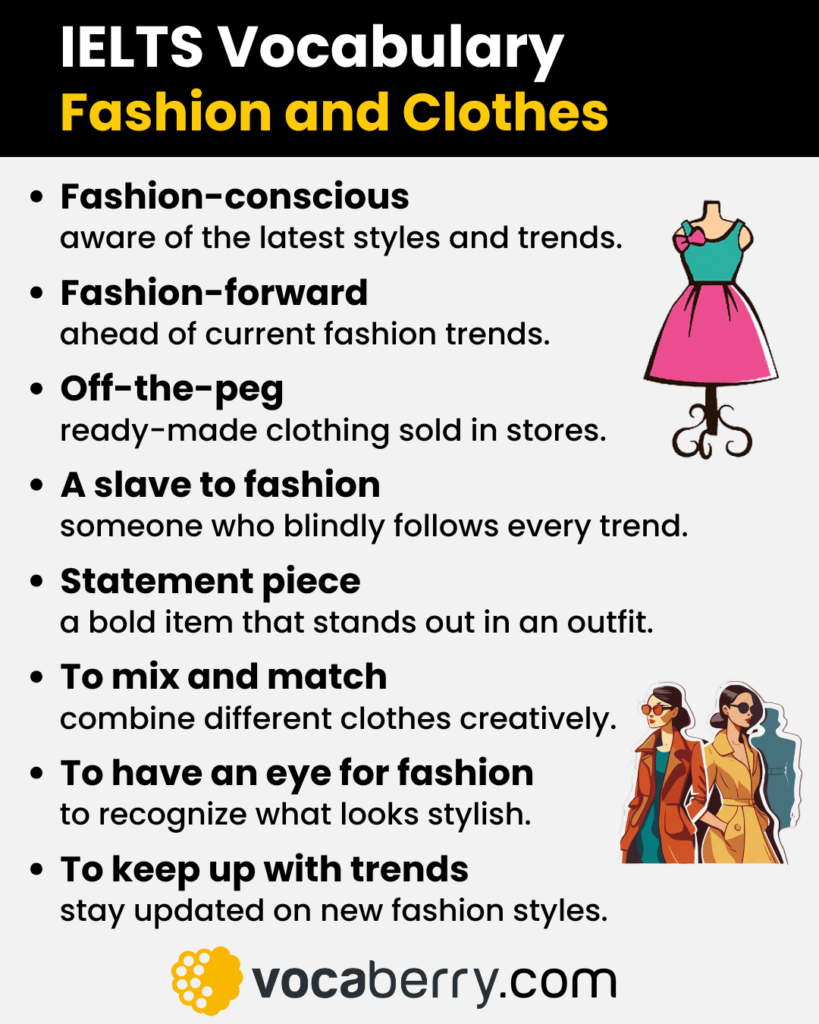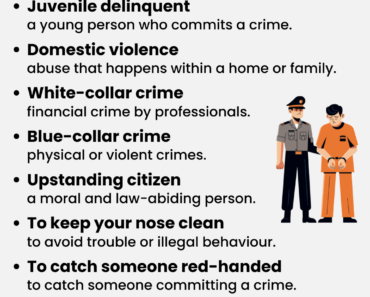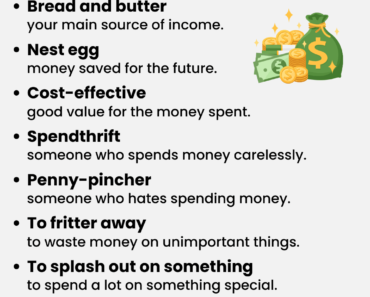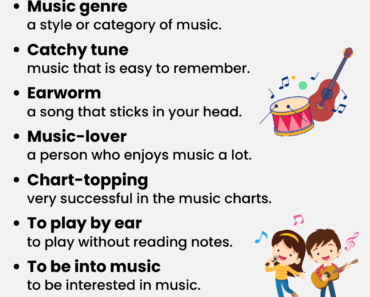
Fashion is another common topic in the IELTS Speaking test. Examiners may ask you about your clothing preferences, shopping habits, favorite styles, or opinions on how fashion influences people’s lives. In this guide, you’ll learn useful IELTS vocabulary for fashion and clothes with clear definitions, followed by IELTS Speaking Part 1, Part 2, and Part 3 questions with sample answers.
IELTS Vocabulary for Fashion and Clothes
Here is some useful IELTS vocabulary for talking about fashion and clothes with clear definitions. These words and phrases will help you give better answers in the IELTS Speaking test.
- Fashion-conscious – aware of the latest trends and styles.
- Trendy – very fashionable or up to date.
- Stylish – elegant and fashionable in appearance.
- Smart casual – neat but informal clothing style.
- Casual wear – comfortable, everyday clothing.
- Formal wear – clothes suitable for special or official events.
- Dress code – rules about what people should wear.
- Chic – stylish and elegantly fashionable.
- Avant-garde – innovative and ahead of its time in fashion.
- Prêt-à-porter – ready-to-wear designer clothing.
- Seamstress – a person who sews clothes professionally.
- Fashionista – someone passionate about fashion and style.
- A slave to fashion – someone who blindly follows every trend.
- Dress to impress – wear clothes that make a strong impression.
- Dressed to the nines – wearing very elegant or formal clothes.
- To get dressed up – wear formal or fancy clothes.
- To dress down – wear something simple or informal.
- To dress casually – wear comfortable, informal clothes.
- To mix and match – combine different pieces creatively.
- To fit someone – to be the right size or shape for someone.
- To suit someone – to look good on a person.
- To match – to go well with another item of clothing.
- To accessorise – to add items like belts or jewellery to complete a look.
- Fashion statement – clothing that shows personality or attitude.
- Vintage clothes – old-fashioned clothes from a past era.
- Sense of style – knowing what looks good and suits you.
- To have an eye for fashion – to recognize what looks stylish.
- To have a good fashion sense – understand what’s fashionable and flattering.
- To follow fashion – to keep up with the latest trends.
- To go out of fashion – become outdated or unpopular.
- To come into fashion – become popular or trendy.
- To set a trend – to introduce a style that becomes popular.
- To make a fashion comeback – become popular again after being out of style.
- Fashion-forward – ahead of current trends.
- Trendsetter – a person who starts or popularizes new styles.
- Hand-me-down – clothes passed from one person to another.
- Gender-neutral – clothing suitable for any gender.
- In vogue – fashionable or popular at the moment.
- Glamorous – attractive in a sophisticated and elegant way.
- Sophisticated – showing refined taste or style.
- Cutting-edge – extremely modern and innovative.
- Timeless style – fashion that never goes out of date.
- Off-the-peg – ready-made clothing sold in standard sizes.
- Must-have – an essential or highly desirable fashion item.
- Fashion victim – someone who follows every trend blindly.
- Designer label – clothing made by a famous brand.
- Second-hand clothes – pre-owned clothing sold again.
- Brand-name clothes – clothing made by well-known brands.
- Brand loyalty – preference for buying one brand repeatedly.
- Tailor-made / custom-made – made to fit a specific person.
- Haute couture – high-end fashion made by top designers.
- Bespoke – custom-made to a person’s exact measurements.
- Ready-to-wear – clothing produced in standard sizes, available in stores.
- Fast fashion – cheap, quickly produced trendy clothing.
- Capsule wardrobe – a small, versatile set of clothes that all work together.
- Eco-friendly fashion – clothing made sustainably from green materials.
- Slow fashion – promoting quality, ethical, and sustainable fashion.
- Minimalist style – simple clothing with clean, neutral designs.
- Vintage fashion – styles from previous decades.
- Retro look – clothes inspired by past fashion trends.
- To be on trend – to wear what’s currently fashionable.
- To be out of style – to wear old-fashioned clothes.
- To pull off a look – to look good wearing something bold.
- To put together an outfit – to choose and combine clothes that match.
- To throw on something – to put on clothes quickly without thinking.
- To dress appropriately – wear suitable clothes for the situation.
- To dress for the occasion – choose clothes suitable for an event.
- To be overdressed – wearing clothes too formal for an occasion.
- To be underdressed – wearing clothes too casual for an event.
- To be well-dressed – wearing attractive, suitable clothes.
- To keep up with trends – stay informed about new fashion styles.
- Latest fashion trend – the most current and popular style.
- Runway / catwalk – a platform where models show new designs.
- Fashion designer – person who creates clothing designs.
- Fashion show – event where models present new collections.
- Fashion industry – the business of designing and selling clothes.
- Fashion icon – someone admired for their unique style.
- Fashion faux pas – a noticeable style mistake.
- Wardrobe staple – a basic item you wear often, like a white shirt.
- Statement piece – a bold item that stands out in an outfit.
- To take pride in one’s appearance – to care about looking good.
- To express yourself through fashion – to show your identity by how you dress.
- To revamp your wardrobe – update your clothing collection.
- To splurge on clothes – spend a lot of money on fashion items.
- To shop till you drop – to spend a long time shopping.
- To fit like a glove – when clothes fit perfectly.
- To be dressed to kill – to wear something striking or impressive.
- To look sharp – to appear neat and stylish.
- To turn heads – to attract attention with your appearance.
- To feel comfortable in your own skin – to be confident with your style.
IELTS Speaking: Fashion and Clothes Questions & Answers
In this section, you’ll find IELTS Speaking Part 1, Part 2, and Part 3 questions on fashion and clothes with sample answers. These examples show how the fashion vocabulary can be used in your responses during the test.
IELTS Speaking Part 1 – Fashion and Clothes
Do you like fashion?
Yes, I’d say I’m quite fashion-conscious because I enjoy keeping up with latest fashion trends and exploring new styles. Fashion lets me express myself through what I wear, and I find it exciting to see how designers constantly create cutting-edge ideas that influence everyday looks.
What kind of clothes do you usually wear?
Most days, I go for a smart casual style since it’s both neat and comfortable. I like to mix and match classic items with something chic, like a tailored jacket or stylish shoes. It helps me feel confident while still being practical for work or social events.
Do you care about brand-name clothes?
Not too much, but I do appreciate brand-name clothes for their quality and design. I’m not a slave to fashion, so I prefer timeless pieces rather than following every latest fashion trend. For me, comfort and durability matter more than showing off a logo.
Do you follow fashion trends?
I try to keep up with trends, especially through social media and magazines, but I don’t copy them blindly. I prefer styles that actually suit me and help me feel comfortable in my own skin. Sometimes I even set my own trend by adding a personal touch to what I wear.
What kind of clothes do you find comfortable?
I like clothes that are well-fitted but easy to move in. Ready-to-wear pieces made from soft, breathable fabrics are my go-to choices. I also love eco-friendly fashion, because it feels good to wear something stylish that’s also sustainable.
Do you think clothes can reflect a person’s personality?
Definitely. The way someone dresses can be a real fashion statement. For example, people with a bold sense of style often wear statement pieces or avant-garde designs, while others prefer a more minimalist style that shows simplicity and confidence.
IELTS Speaking Part 2 – Fashion and Clothes Cue Card
Describe a piece of clothing you love to wear.
You should say:
- what it is
- when you wear it
- where you got it
- and explain why you like it so much
Sample Answer:
One piece of clothing that I absolutely love wearing is a tailor-made blazer that I had specially designed about two years ago. It’s a chic, navy-blue jacket made from soft Italian wool, and it fits me like a glove. I had it done by a local seamstress who offers bespoke services, so every stitch and detail was adjusted exactly to my size. Compared to anything you buy off-the-peg, it feels far more personal and sophisticated.
I usually wear it for formal wear occasions such as job interviews, family gatherings, or important meetings where I want to dress to impress. But sometimes, I also pair it with jeans and sneakers to create a smart casual look that’s still polished yet relaxed. Because it’s such a versatile piece, I can easily mix and match it with different outfits, depending on the occasion. It’s become my wardrobe staple, the kind of item that I can always rely on when I want to look effortlessly stylish and confident.
What I really love about this blazer is that it has a timeless style. Even though fashion trends come into fashion and go out of fashion so quickly these days, I know this piece will never look outdated. The cut is fashion-forward but not over the top, so it stays elegant no matter what’s currently in vogue. It’s one of those must-have items that can instantly pull off a look and make me feel well-dressed without much effort.
Another reason I value it so much is because of its quality and sustainability. I try to avoid fast fashion as much as possible and support slow fashion or eco-friendly fashion brands that focus on durability and ethical production. I like knowing that what I wear was made thoughtfully rather than mass-produced. This mindset has really changed how I shop and helped me take pride in my appearance without being a slave to fashion.
Whenever I wear this blazer, I feel comfortable, confident, and completely in my own skin. It reflects my personal sense of style perfectly: simple, elegant, and just a little fashion-forward. For me, it’s not just clothing; it’s a statement piece that shows who I am, someone who appreciates quality, individuality, and timeless elegance.
IELTS Speaking Part 3 – Fashion and Clothes Discussion
IELTS Speaking Part 3 questions about fashion often ask you to compare traditional and modern styles, discuss the influence of fashion on society, and give opinions on issues such as fast fashion, sustainability, and the impact of social media on clothing trends.
How has fashion changed compared to the past?
Fashion has changed enormously over time. In the past, people followed strict dress codes and wore formal wear almost every day, while now there’s a clear shift towards casual wear and smart casual styles. Comfort has become just as important as appearance. People today like to mix and match clothes to create their own look instead of copying trends blindly. Another big change is that more people are becoming fashion-conscious about sustainability, so eco-friendly fashion and slow fashion are becoming more popular. Instead of chasing fast fashion, many people now prefer timeless styles and a smaller capsule wardrobe.
Why do people follow fashion trends?
People follow fashion trends for many reasons. Some are naturally fashion-conscious and want to stay on trend because it helps them feel confident and updated. Others see fashion as a way to express themselves through clothing or to project a certain image. Nowadays, trendsetters, fashion icons, and influencers on social media play a massive role in shaping what’s in vogue. However, not everyone follows trends for the right reasons. Some people become slaves to fashion, buying whatever’s new without thinking about their sense of style or whether it suits them. Personally, I think following trends is fine, as long as you know how to pull off a look that reflects your personality.
How does fashion reflect someone’s personality?
Fashion is one of the clearest ways to show who you are. Someone with a sense of style might wear chic, elegant clothes that reflect confidence, while another person might prefer vintage fashion to express nostalgia or individuality. Those who enjoy fashion-forward looks or cutting-edge designs are often seen as creative and bold. Meanwhile, people who prefer minimalist styles or smart casual outfits might come across as practical and down-to-earth. Personally, I think the key is to feel comfortable in your own skin and use fashion as a way to take pride in your appearance without feeling the need to impress others.
How has technology influenced the fashion industry?
Technology has completely transformed the fashion industry. Designers now use digital tools to create avant-garde or cutting-edge collections. Shopping has also become much easier, with online stores offering ready-to-wear and custom-made clothes that can be ordered with one click. Social media platforms have given rise to fashion influencers and trendsetters, allowing new latest fashion trends to spread globally in seconds. Even the materials used are evolving, with brands creating eco-friendly and gender-neutral designs using recycled or smart fabrics. Technology has made fashion faster, more inclusive, and much more creative.
More IELTS Vocabulary Topics
If you found this lesson useful, explore other IELTS Speaking topics to expand your vocabulary and practice with sample answers:
- IELTS Vocabulary: Hometown
- IELTS Vocabulary: Childhood
- IELTS Vocabulary: Family
- IELTS Vocabulary: Friends
- IELTS Vocabulary: Hobbies
- IELTS Vocabulary: Education
- IELTS Vocabulary: Food & Diet
- IELTS Vocabulary: Work & Jobs
- IELTS Vocabulary: Daily Routine
- IELTS Vocabulary: Social Media
- IELTS Vocabulary: Travel
- IELTS Vocabulary: Shopping
- IELTS Vocabulary: Weather
- IELTS Vocabulary: Money
- IELTS Vocabulary: Health
- IELTS Vocabulary: Sports
- IELTS Vocabulary: Music
- IELTS Vocabulary: Films
- IELTS Vocabulary: Books
- IELTS Vocabulary: Art
- IELTS Vocabulary: Gifts
- IELTS Vocabulary: Plants
- IELTS Vocabulary: Animals
- IELTS Vocabulary: Transport
- IELTS Vocabulary: Technology
- IELTS Vocabulary: Environment
- IELTS Vocabulary: Advertisement
- IELTS Vocabulary: Accommodation
- IELTS Vocabulary: Artificial Intelligence
- IELTS Vocabulary: Culture and Traditions
- IELTS Vocabulary: Crime and Punishment






